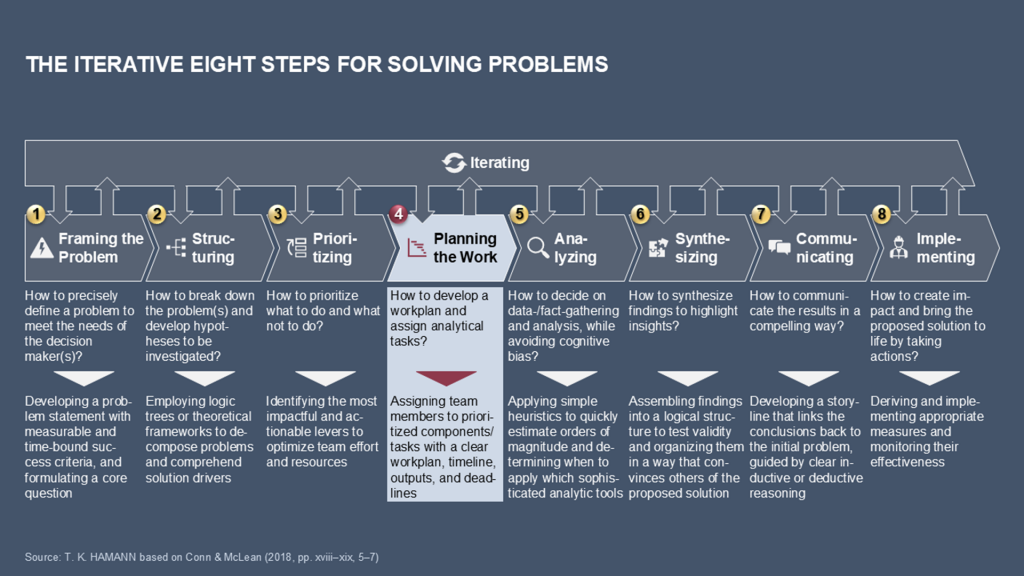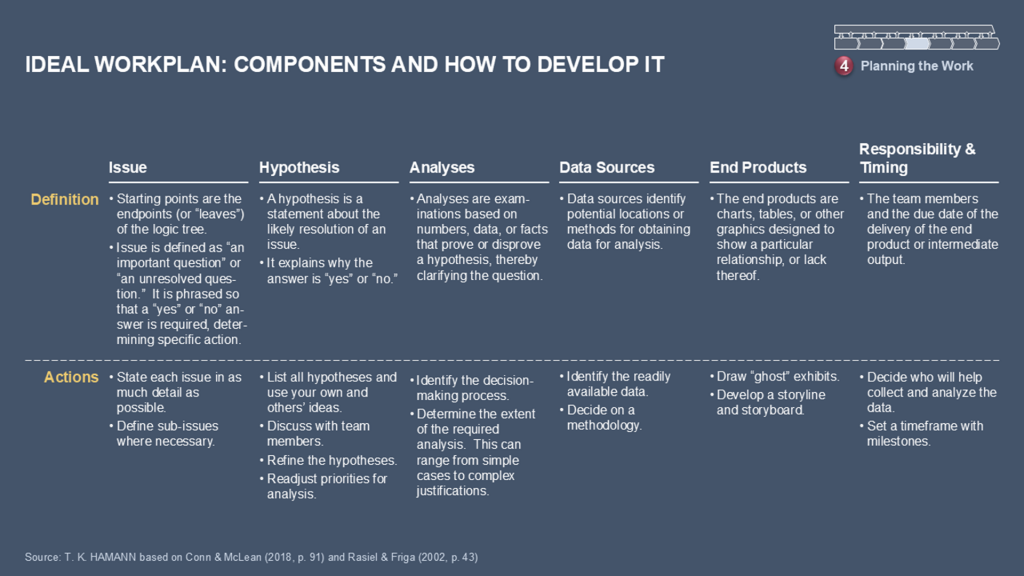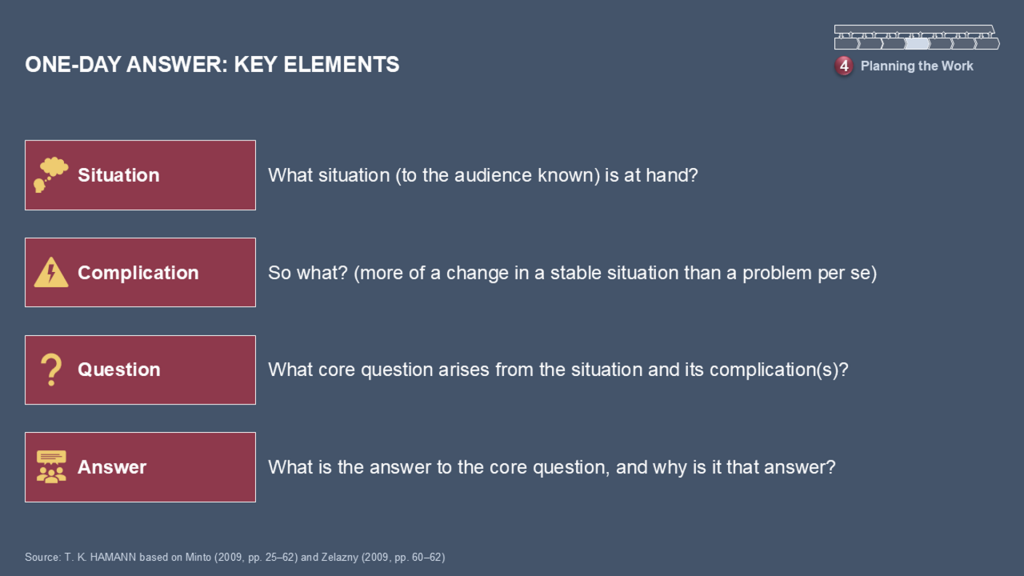The Iterative Eight Steps for Solving Problems – Step 4: Planning the Work
In the first three steps of the Eight Iterative Steps for solving problems—framing the problem, structuring it, and prioritizing—an intellectual foundation was established. This involved defining the problem in a way that aligns with the needs of decision makers, breaking it down into its logical components, and deciding which areas deserved immediate attention.
Now comes the fourth step where ideas turn into action: planning the work (see Exhibit 1). While the earlier steps provided us with a “map” of the problem, work planning determines the actual “route” one will take. It is the bridge between thinking and doing.
Planning the work ensures that problem solving proceeds in a disciplined, efficient, and transparent way. Without planning, even well-framed and well-structured problems risk being approached haphazardly, leading to wasted effort, missed deadlines, and superficial answers. With planning, teams can agree on clear hypotheses, organize data-gathering efforts, and coordinate individual contributions toward meaningful results.

1. From Prioritization to Work Planning
Prioritizing shows us where to focus. Work planning answers the next question: how will we get there?
One of the most important concepts here is the critical path. It is the sequence of tasks and analyses that are essential to solving the problem in the most effective way. By focusing on the critical path, we ensure that resources are invested in analyses most likely to produce actionable insights.
The critical path is the order of analyses and tasks that must be completed to solve the problem; it reflects continued prioritization and ensures focus on the most impactful activities.
In practice, the critical path often begins with knock-out analyses. These are quick tests that can eliminate entire branches of inquiry. Conn & Mc Lean (2018, p. 93) provide an example: a cost reduction team might hypothesize that outsourcing IT could deliver significant savings. However, a quick analysis reveals that, while outsourcing could reduce IT costs by 50 percent, IT represents only 5 percent of the company’s total spending. This finding “knocks out” the IT option, allowing the team to redirect its efforts toward areas with greater potential.
This disciplined approach helps teams avoid the common pitfall of “boiling the ocean”—collecting massive amounts of data and conducting analyses without clear hypotheses or priorities.
2. The Anatomy of a Workplan
A robust work plan is the central management tool for solving problems. It defines what needs to be done, by whom, and by when while maintaining focus on the hypotheses that must be tested.
A typical work plan includes six elements, as shown in Exhibit 2:
- Issues:
The specific problem questions that require answers - Hypotheses:
Tentative answers that guide the analysis and are sometimes amended by a supporting rationale, which serves as an additional explanatory component - Analyses:
The methods or tests needed to confirm or reject each hypothesis - Data Sources:
Where the relevant information will be obtained - End products:
The concrete outputs (e.g., charts, tables, and exhibits) that communicate results - Responsibility and Timing:
Who is accountable for each task, and when is it due?
A hypothesis is a tentative explanation or prediction about a problem; it is formulated in a way that can be tested through analysis and evidence, either being confirmed or disproved.
This model is powerful because of its specificity. Each hypothesis is linked to an explicit output with a deadline and a responsible owner. This model avoids ambiguity (“I thought you were going to run that analysis!”) and fosters accountability across the team.

3. Best Practices in Work Planning
3.1 Hypothesis-Driven Analysis
Effective problem solving is hypothesis-driven. This means that every analysis begins with a clear idea of what the results might show. To sharpen this focus, teams often “dummy the chart” by sketching what the final exhibit would look like if the hypothesis were correct. This simple act forces clarity. If you cannot imagine what the output might look like, perhaps the analysis should not be pursued.
3.2 Knock-out Analyses and the 80/20 Rule
As mentioned earlier, knock-out analyses come first. They prevent wasted effort by testing whether major hypotheses are worth pursuing. This reflects the Pareto principle, also known as the 80/20 rule, which states that 20 percent of inputs generate 80 percent of outputs.
3.3 Chunky Workplans and Lean Project Plans
Workplans should be chunky—short, specific, and covering only the immediate two to three weeks of work. In parallel, a lean project plan, usually in Gantt chart format, ensures alignment with overall milestones but avoids the trap of micromanaging every detail months in advance. This combination provides both focus and flexibility.
A chunky workplan is a brief, highly specific plan that covers the next few weeks of analysis and output; it is updated frequently as new insights emerge.
3.4 One-Day Answers
Another best practice is to articulate one-day answers. These are concise statements of the team’s best current understanding of the situation, expressed in the Situation–Complication–Question–Answer format (see Exhibit 3). Even if rough, these provisional answers crystallize the state of knowledge, highlight uncertainties, and provide a strawman for further testing.
A one-day answer is a summary of the team’s current understanding of the problem; it is usually expressed as a situation, complication, and resolution.

4. Work planning in Teams
4.1 Roles and Responsibilities
In team-based problem solving, the work plan serves as the collective contract. Everyone knows who is doing what and when it is due. Effective teams often combine strong coordination with a project lead who acts like a combination of “a musical conductor and an air traffic controller” (Conn & McLean 2018, p. 97, along with flat structures that encourage open brainstorming.
4.2 Team Norms for Problem Solving
High-performing teams share certain norms:
- They maintain a hypothesis-driven and output- and end-product-oriented approach.
- They are flexible and quickly abandon dead-end analyses.
- They seek breakthrough thinking, often by looking outside their industry for inspiration. According to Conn and McLean (2018, p. 99), one mining company learned about faster tire changes by studying Formula 1 pit crews.
4.3 Guarding Against Bias
Cognitive biases can easily distort work planning. For example, confirmation bias may cause a team to collect only supporting evidence. Anchoring bias can cause early data points to have too much influence on conclusions. Loss aversion can result in an inability to ignore the unequal valuation of losses and gains. Availability bias can cause us to use an existing mental map, even if it is not adequate for the problem at hand, because it is readily available. Overoptimism can blind teams to downside risks.
Confirmation bias is the tendency to seek out and favor information that supports one’s existing beliefs while ignoring contradictory evidence.
To mitigate these risks, teams should adopt explicit processes, such as the following:
- Obligation to dissent: Every team member should be encouraged and required to challenge assumptions.
- Role-playing: Testing ideas from different perspectives, such as that of a skeptical CEO or a dissatisfied customer.
- Pre-mortems: Imagine the project has failed and work backward to identify why.
- Diverse input: Engaging people with different backgrounds to broaden perspectives.
5. Agile and Iterative Problem Solving
Planning the work is not a one-off exercise. Because new insights emerge constantly, the workplan must be iterative. Agile approaches—short cycles of planning, testing, and adjusting—are particularly effective.
Rather than a rigid, encyclopedic plan, the best problem solvers rely on living documents that evolve with each round of analysis. This not only keeps teams focused on the critical path but also ensures adaptability in the face of surprises.
6. Process Maps, Content Maps, and Storylines
According to Friga (2009, pp. 110–114), a consulting practice often distinguishes three organizing tools within work planning:
- Process map:
A high-level outline of what needs to be done, who will do it, and when it needs to be done by - Content map:
A detailed plan of the hypotheses to be tested and the required analyses - Storyline:
A preliminary draft of the narrative that will ultimately communicate the derivation of the solution
The storyline deserves particular attention. Drafting it early on, even before the analyses are complete, forces the team to clarify what the likely answers could be and how the findings will be communicated. As data accumulate, the storyline evolves into a storyboard, but its early presence keeps analyses focused and integrated. The storyboard translates a storyline into a slide deck with data-supported insights. To organize your storyboard, you can either draw a collection of miniaturized comic-like charts or, for a more flexible approach, use sticky notes, with each note representing an exhibit.
7. Key Takeaways
- The planning process transforms ideas into action by defining hypotheses, analyses, data sources, outputs, and responsibilities.
- The critical path ensures that the most important analyses are prioritized, beginning with knock-out analyses.
- Work plans should be concise and specific and supported by lean project plans with key milestones.
- One-day answers clarify current understanding and guide iteration.
- Strong team processes, such as dissent, role-playing, and pre-mortems, help overcome bias and foster creativity.
- Work plans are living documents that are constantly updated through agile, iterative cycles.
- Tools such as process maps, content maps, and storylines help maintain alignment between analysis and communication.
References
Conn C, McLean R (2018) Bulletproof Problem Solving (Wiley, Hoboken, NJ).
Friga PN (2009) The McKinsey Engagement: A Powerful Toolkit for More Efficient & Effective Problem Solving (McGraw-Hill, New York, NY).
Minto, B (2009) The Pyramid Principle: Logic in Writing and Thinking (Harlow, United Kingdom).
Rasiel EM, Friga PN (2002) The McKinsey Mind: Understanding and Implementing the Problem-Solving Tools and management techniques of the World’s Top strategic Consulting Firm (McGraw-Hill, New York, NY).
Zelazny, G (2009) Das Präsentationsbuch [Say it with Presentations: How to Design and Deliver Successful Business Presentations] (Campus, Frankfurt am Main, Germany).
